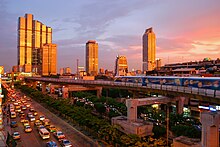Total energy supply 2021[1]

Energy in Thailand refers to the production, storage, import and export, and use of energy in the Southeast Asian nation of Thailand. Thailand's energy resources are modest and being depleted. The nation imports most of its oil and significant quantities of natural gas and coal. Its energy consumption has grown at an average rate of 3.3% from 2007 to 2017. Energy from renewables has only recently begun to contribute significant energy.
In 2023, natural gas accounted for the highest total power generation capacity, followed by coal and lignite, with a significant presence of 13 natural gas production facilities, primarily in the Gulf of Thailand. From January to November 2023, the value of energy imports and exports amounted to almost 1.89 trillion Thai baht. Energy consumption that year was around two million barrels worth of commercial primary energy oil equivalent, mainly from petroleum products and natural gas. The Thai government is actively promoting renewable energy to reduce fossil fuel dependency and has seen a year-on-year increase in the usage of renewables.[2]
There is some disparity in published figures: according to the Ministry of Energy, the country's primary energy consumption was 75.2 Mtoe (million tonnes of oil equivalent, equalling around 875 TWh) in 2013.[3] According to BP, primary energy consumption in 2013 was 118.3 Mtoe, rising to 133 Mtoe in 2018.[4]: 8
The energy policy of Thailand is characterized by 1) increasing energy consumption efficiency, 2) increasing domestic energy production, 3) increasing the private sector's role in the energy sector, 4) increasing the role of market mechanisms in setting energy prices. These policies have been consistent since the 1990s, despite various changes in governments. The pace and form of industry liberalization and privatization has been highly controversial.

- ^ "Thailand - Countries & Regions". IEA. Retrieved 2024-04-24.
- ^ "Energy sector in Thailand - statistics & facts". www.statista.com/. 2024-03-05. Retrieved 28 April 2024.
- ^ "Energy in Thailand, Facts & Figures 2013" (PDF). Department of Alternative Energy Development & Efficiency. Archived (PDF) from the original on 11 September 2014. Retrieved 5 September 2014.
- ^ BP Statistical Review of World Energy 2019 (PDF) (68th ed.). London: BP. 2019. Archived (PDF) from the original on 2020-10-17. Retrieved 2019-09-27.